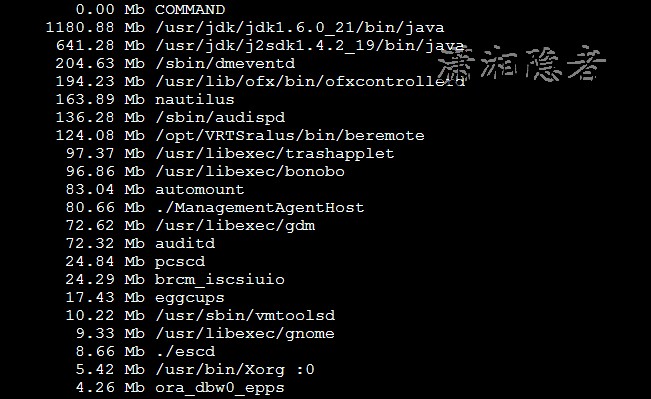(點選上方公眾號,可快速關註)
來源:瀟湘隱者 ,
www.cnblogs.com/kerrycode/p/9568854.html
在Linux中,有很多命令或工具檢視記憶體使用情況,今天我們來看看如何檢視行程消耗、佔用的記憶體情況,Linux的記憶體管理和相關概念要比Windows複雜一些。在此之前,我們需要瞭解一下Linux系統下麵有關記憶體的專用名詞和專業術語概念:
物理記憶體和虛擬記憶體
物理記憶體:就是系統硬體提供的記憶體大小,是真正的記憶體,一般叫做記憶體條。也叫隨機存取儲存器(random access memory,RAM)又稱作“隨機儲存器”,是與CPU直接交換資料的內部儲存器,也叫主存(記憶體)。
虛擬記憶體:相對於物理記憶體,在Linux下還有一個虛擬記憶體的概念,虛擬記憶體就是為了滿足物理記憶體的不足而提出的策略,它是利用磁碟空間虛擬出的一塊邏輯記憶體,用作虛擬記憶體的磁碟空間被稱為交換空間(Swap Space)。Linux會在物理記憶體不足時,使用虛擬記憶體,核心會把暫時不用的記憶體塊資訊寫到虛擬記憶體,這樣物理記憶體就得到了釋放,這塊兒記憶體就可以用於其他目的,而需要用到這些內容的時候,這些資訊就會被重新從虛擬記憶體讀入物理記憶體。
Linux的buffers與cached
在Linux中經常發現空閑的記憶體很少,似乎所有的記憶體都被消耗殆盡了,錶面上看是記憶體不夠用了,很多新手看到記憶體被“消耗殆盡”非常緊張,其實這個是因為Linux系統將空閑的記憶體用來做磁碟檔案資料的快取。這個導致你的系統看起來處於記憶體非常緊急的狀況。但是實際上不是這樣。這個區別於Windows的記憶體管理。Linux會利用空閑的記憶體來做cached & buffers。
buffers是指用來給塊裝置做的緩衝大小(塊裝置的讀寫緩衝區),它只記錄檔案系統的metadata以及 tracking in-flight pages.
Buffers are associated with a specific block device, and cover caching of filesystem metadata as well as tracking in-flight pages. The cache only contains parked file data. That is, the buffers remember what’s in directories, what file permissions are, and keep track of what memory is being written from or read to for a particular block device. The cache only contains the contents of the files themselves.
cached是作為page cache的記憶體, 檔案系統的cache。你讀寫檔案的時候,Linux核心為了提高讀寫效能與速度,會將檔案在記憶體中進行快取,這部分記憶體就是Cache Memory(快取記憶體)。即使你的程式執行結束後,Cache Memory也不會自動釋放。這就會導致你在Linux系統中程式頻繁讀寫檔案後,你會發現可用物理記憶體會很少。其實這快取記憶體(Cache Memory)在你需要使用記憶體的時候會自動釋放,所以你不必擔心沒有記憶體可用
Cached is the size of the page cache. Buffers is the size of in-memory block I/O buffers. Cached matters; Buffers is largely irrelevant.
Cached is the size of the Linux page cache, minus the memory in the swap cache, which is represented by SwapCached (thus the total page cache size is Cached + SwapCached). Linux performs all file I/O through the page cache. Writes are implemented as simply marking as dirty the corresponding pages in the page cache; the flusher threads then periodically write back to disk any dirty pages. Reads are implemented by returning the data from the page cache; if the data is not yet in the cache, it is first populated. On a modern Linux system, Cached can easily be several gigabytes. It will shrink only in response to memory pressure. The system will purge the page cache along with swapping data out to disk to make available more memory as needed.
Buffers are in-memory block I/O buffers. They are relatively short-lived. Prior to Linux kernel version 2.4, Linux had separate page and buffer caches. Since 2.4, the page and buffer cache are unified and Buffers is raw disk blocks not represented in the page cache—i.e., not file data. The Buffers metric is thus of minimal importance. On most systems, Buffers is often only tens of megabytes.
Linux共享記憶體
共享記憶體是行程間通訊中最簡單的方式之一。共享記憶體允許兩個或更多行程訪問同一塊記憶體,就如同 malloc() 函式向不同行程傳回了指向同一個物理記憶體區域的指標。當一個行程改變了這塊地址中的內容的時候,其它行程都會察覺到這個。其實所謂共享記憶體,就是多個行程間共同地使用同一段物理記憶體空間,它是透過將同一段物理記憶體對映到不同行程的虛擬空間來實現的。由於對映到不同行程的虛擬空間中,不同行程可以直接使用,不需要像訊息佇列那樣進行複製,所以共享記憶體的效率很高。共享記憶體可以透過mmap()對映普通檔案機制來實現,也可以System V共享記憶體機制來實現,System V是透過對映特殊檔案系統shm中的檔案實現行程間的共享記憶體通訊,也就是說每個共享記憶體區域對應特殊檔案系統shm中的一個檔案。
另外,我們還必須瞭解RSS、PSS、USS等相關概念:
-
VSS – Virtual Set Size 虛擬耗用記憶體(包含共享庫佔用的記憶體)
-
RSS – Resident Set Size 實際使用物理記憶體(包含共享庫佔用的記憶體)
-
PSS – Proportional Set Size 實際使用的物理記憶體(比例分配共享庫佔用的記憶體)
-
USS – Unique Set Size 行程獨自佔用的物理記憶體(不包含共享庫佔用的記憶體)
RSS(Resident set size),使用top命令可以查詢到,是最常用的記憶體指標,表示行程佔用的物理記憶體大小。但是,將各行程的RSS值相加,通常會超出整個系統的記憶體消耗,這是因為RSS中包含了各行程間共享的記憶體。
PSS(Proportional set size)所有使用某共享庫的程式均分該共享庫佔用的記憶體時,每個行程佔用的記憶體。顯然所有行程的PSS之和就是系統的記憶體使用量。它會更準確一些,它將共享記憶體的大小進行平均後,再分攤到各行程上去。
USS(Unique set size )行程獨自佔用的記憶體,它是PSS中自己的部分,它只計算了行程獨自佔用的記憶體大小,不包含任何共享的部分。
所以下麵介紹的命令,有些檢視行程的虛擬記憶體使用,有些是檢視行程的RSS或實際物理記憶體。在講述的時候,我們會標註這些資訊。
top命令檢視
執行top命令後,執行SHIFT +F ,可以選擇按某列排序,例如選擇n後,就會按欄位%MEM排序

當然也可以使用shift+m 或大寫鍵M 讓top命令按欄位%MEM來排序,當然你也可以按VIRT(虛擬記憶體)、SWAP(行程使用的SWAP空間)、RES(實際使用物理記憶體,當然這裡由於涉及共享記憶體緣故,你看到的實際記憶體非常大)
%MEM — Memory usage (RES)
A task’s currently used share of available physical memory
VIRT — virtual memory
The total amount of virtual memory used by the task. It includes all code, data and shared libraries plus pages that have been swapped out. (Note: you can define the STATSIZE=1 environment variable and the VIRT will be calculated from the /proc/#/state VmSize field.)
VIRT = SWAP + RES
SWAP — Swapped size (kb)
The swapped out portion of a task’s total virtual memory image.
RES — Resident size (kb)
RES = CODE + DATA.
是否有人會覺得奇怪,為什麼%MEM這一列的值加起來會大於100呢? 這個是因為這裡計算的時候包含了共享記憶體的緣故,另外由於共享記憶體的緣故,你看到行程使用VIRT或RES都非常高。由於大部分的物理記憶體通常在多個應用程式之間共享,名為實際使用物理記憶體(RSS,對應top命令裡面的RES)的這個標準的記憶體耗用衡量指標會大大高估記憶體耗用情況。

ps命令檢視
使用ps命令找出佔用記憶體資源最多的20個行程(數量可以任意設定)
# ps aux | head -1;ps aux |grep -v PID |sort -rn -k +4 | head -20
USER PID %CPU %MEM VSZ RSS TTY STAT START TIME COMMAND
oracle 32147 11.0 51.2 13252080 12666320 ? Rs Aug24 163:16 ora_s000_SCM2
oracle 32149 14.2 50.9 13250344 12594264 ? Ss Aug24 210:41 ora_s001_SCM2
oracle 32153 4.2 49.6 13250820 12279432 ? Ss Aug24 62:27 ora_s003_SCM2
oracle 32155 2.5 48.6 13250268 12040732 ? Ss Aug24 38:21 ora_s004_SCM2
oracle 32157 1.2 44.5 13250296 11011708 ? Ss Aug24 18:31 ora_s005_SCM2
oracle 32151 2.7 39.7 13350436 9829944 ? Ss Aug24 41:18 ora_s002_SCM2
oracle 32159 0.5 38.9 13250704 9625764 ? Ss Aug24 8:18 ora_s006_SCM2
oracle 32161 0.2 26.3 13250668 6507244 ? Ss Aug24 3:38 ora_s007_SCM2
oracle 32129 0.0 25.5 13299084 6324644 ? Ss Aug24 1:25 ora_dbw0_SCM2
oracle 32181 0.0 15.8 13250152 3913260 ? Ss Aug24 0:56 ora_s017_SCM2
oracle 32145 2.7 15.3 13255256 3786456 ? Ss Aug24 40:11 ora_d000_SCM2
oracle 32127 0.0 15.2 13248996 3762860 ? Ss Aug24 0:05 ora_mman_SCM2
oracle 32163 0.0 14.2 13250108 3525160 ? Ss Aug24 1:04 ora_s008_SCM2
oracle 32165 0.0 8.1 13250172 2007704 ? Ss Aug24 0:37 ora_s009_SCM2
oracle 32169 0.0 6.6 13250060 1656864 ? Ss Aug24 0:08 ora_s011_SCM2
oracle 32177 0.0 6.0 13250148 1498760 ? Ss Aug24 0:12 ora_s015_SCM2
oracle 32187 0.0 5.1 13250084 1267384 ? Ss Aug24 0:06 ora_s020_SCM2
oracle 32179 0.0 5.1 13250584 1280156 ? Ss Aug24 0:05 ora_s016_SCM2
oracle 32167 0.0 5.0 13250060 1248668 ? Ss Aug24 0:08 ora_s010_SCM2
oracle 32175 0.0 3.4 13250596 857380 ? Ss Aug24 0:03 ora_s014_SCM2
#ps -eo pmem,pcpu,rss,vsize,args | sort -k 1 -n -r | less
檢視行程佔用的實際物理記憶體(與smem看到實際物理記憶體大小有出入,這裡解釋一下:SIZE: 行程使用的地址空間, 如果行程映射了100M的記憶體, 行程的地址空間將報告為100M記憶體. 事實上, 這個大小不是一個程式實際使用的記憶體數. 所以這裡看到的記憶體跟smem看到的大小有出入)
ps -eo size,pid,user,command –sort -size | awk ‘{ hr=$1/1024 ; printf(“%13.2f Mb “,hr) } { for ( x=4 ; x<=NF ; x++ ) { printf("%s ",$x) } print "" }' |cut -d "" -f2 | cut -d "-" -f1

ps aux | awk ‘{print $6/1024 ” MB\t\t” $11}’ | sort -n
smem命令檢視
關於smem命令,這裡不做介紹,直接參考連結Linux監控工具介紹系列——smem
#smem -rs pss

pmap命令檢視
# ps -ef | grep tomcat
# pmap 32341

# pmap -x 32341
The -x option can be used to provide information about the memory allocation and mapping types per mapping. The amount of resident, non-shared anonymous, and locked memory is shown for each mapping。

python指令碼檢視
網上有個python指令碼計算程式或行程的記憶體使用情況,地址位於https://raw.githubusercontent.com/pixelb/ps_mem/master/ps_mem.py
python ps_mem.py

[root@mylnx03 ~]# python ps_mem.py -h
Usage: ps_mem [OPTION]…
Show program core memory usage
-h, -help Show this help
-p
[,pid2,…pidN] Only show memory usage PIDs in the specified list -s, –split-args Show and separate by, all command line arguments
-t, –total Show only the total value
-d, –discriminate-by-pid Show by process rather than by program
-S, –swap Show swap information
-w
Measure and show process memory every N seconds [root@mylnx03 ~]# python ps_mem.py -p 32341
Private + Shared = RAM used Program
411.2 MiB + 184.0 KiB = 411.4 MiB java
———————————
411.4 MiB
=================================
參考資料:
-
https://stackoverflow.com/questions/131303/how-to-measure-actual-memory-usage-of-an-application-or-process
-
http://www.cnblogs.com/kerrycode/p/5079319.html
-
https://raw.githubusercontent.com/pixelb/ps_mem/master/ps_mem.py
【關於投稿】
如果大家有原創好文投稿,請直接給公號傳送留言。
① 留言格式:
【投稿】+《 文章標題》+ 文章連結
② 示例:
【投稿】《不要自稱是程式員,我十多年的 IT 職場總結》:http://blog.jobbole.com/94148/
③ 最後請附上您的個人簡介哈~
看完本文有收穫?請轉發分享給更多人
關註「ImportNew」,提升Java技能

 知識星球
知識星球